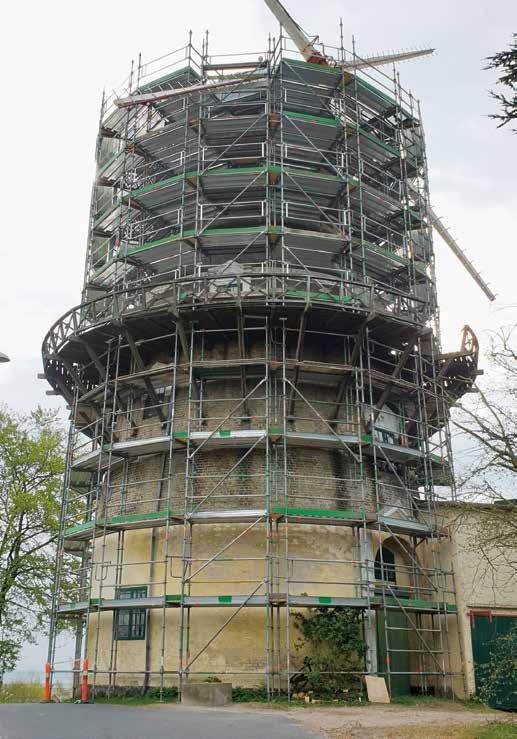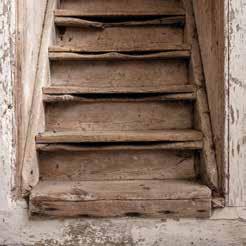
5 minute read
English summary
English summary: Dyrehave Mølle (Mill)
– A dutch Windmill from 1858
In the market town/port of Nyborg on the Danish island of Funen, there is a well-preserved Dutch windmill dating from 1858 – Dyrehave Mølle (Deer Park Mill). It was named after its location in a former royal deer park.
For more than 100 years, Dyrehave Mølle housed an important manufacturing company in the local area. Since the mill ceased operations in 1976, it has been a popular landmark for the people of Nyborg and for visitors both on land and at sea. For seamen, in particular, it has been a crucial point of orientation.
Once there were hundreds of such windmills throughout Denmark; today there are very few left. Industrialisation and large-scale operation gradually made them redundant, and most of them were demolished.
In 2018, Realdania By & Byg acquired the listed, extremely well-preserved Dyrehave Mølle and extensively refurbished both the mill itself and the other historic buildings surrounding it. While the mill has remained largely unchanged, today the farmhouse, garage and storage building have been converted into residential and commercial premises.
Together, the mill, the other buildings and the large market garden constitute a cohesive, pre-industrial cultural environment and a unique piece of Danish history. Everything is now preserved for posterity, and a new chapter in the history of Dyrehave Mølle can begin.
From top to bottom, Dyrehave Mølle provides an intimate, palpable story of a technology that played an indispensable role in an agricultural country such as Denmark. At a height of 25 metres, Dyrehave Mølle is one of the tallest Dutch mills in Denmark, while the use of cement – a brand new material at the time, produced on the Danish island of Bornholm – also made it one of the most modern.
Well-preserved and intact windmill equipment
Inside, Dyrehave Mølle and its well-preserved fixtures and fittings have an abundance of valuable stories to tell. The pebble stone-covered carriage passage right through the body of the mill, the seven preserved floors – each with its own special function in the overall mill system – and all the intact milling equipment in the shape of grinders, sieves and hoists are all extremely well preserved and paint a highly-detailed picture of a bygone era.
The ongoing modernisation and streamlining also contribute to the narrative and understanding of the
evolution the mill has undergone. The so-called La Cour blades, with which the mill was fitted in 1922, and the diesel engine, which was added in 1923, testify to the importance of the mill as the premises of a modern, locally-rooted manufacturing company.
Then, take all the scrapes and scratches and hand-written notes on the mill’s woodwork, added over the years and evidence of the hard, strenuous work. No part of the mill has been subjected to ham-fisted repairs. On the contrary. Everything was repaired in accordance with the rules of windmill architecture and good, sturdy materials.
The mill, the farmhouse, the storage building and the garage were owned by the same family for more than 100 years, and everything was always well taken care of.
Dyrehave Mølle now belongs to Realdania By & Byg’s collection of more than 60 historic properties. Both individually and collectively, they tell the story of Danish building culture, serving as examples of how Denmark’s architectural heritage can be brought to life and promoted on the basis of conservation, change and development. In the future, Dyrehave Mølle will occasionally be open to the public.
Kilder og litteratur
Litteraturliste:
Andersen, Lise: Træk af dansk møllebyggeris historie, 2011. Andersen, H.C.: Eventyr, bd. IV, C. A. Reitzel. Eventyret “Veirmøllen”, 1990. Christensen, Lars: “En lykkelig sejrvinding”. Svenskerne på Østfyn, 2009. Christensen, Lars: “En uskyldig Jagtfornøjelse og Motion”. Jagt og dyrehave ved Nyborg gennem tiden, 2016. Christensen, Niels: De fynske kornmøller og deres møllere ca. 1660-1800, 1985. Ejlersen, Torben: “Møller i Danmark 1802”, i Møllebygninger i Danmark. Redegørelse og status 1993.
Miljøministeriet, Skov- og Naturstyrelsen, 1993. Etting, Vivian og Møller, Per Grau (red.): De kulturhistoriske interesser i landskabet, Skov- og Naturstyrelsen, 1996. Hansen, Robert Sylvest: Dyrehave Mølle, 1958. Lampe, Jens, m.fl. (red): Møller og møllere i Danmark gennem 100 år. Dansk Møllerforening 18841984, Århus 1984 Mortensøn, Ole: “Vindmøller i Danmark – fra stubmølle til hurtigløber” i Møllebygninger i Danmark.
Redegørelse og status 1993. Miljøministeriet,
Skov- og Naturstyrelsen, 1993. Linde-Laursen, Anders: Mølleriets historie, 1986. Lorenzen, Vilh.: “Erik Dahlbergs spionvirksomhed på Fyn” i Fynske Årbøger, 1955, s. 465-480. Solvang, Gunnar: “Vand- og vindmøller” i Vivian
Etting og Per Grau Møller (red.): De kulturhistoriske interesser i landskabet”, Skov- og Naturstyrelsen, 1996.
Andet trykt materiale, opslagsværker og materiale på web
Chronologisk Register over de Kongelige Forordninger og Åbne Breve, samt andre trykte Anordninger ved Jacob Henric Schou, XIX Deels, 3.
Stykke, 1826. Den danske ordbog, www.ordnet.dk Erhvervsstyrelsens stamdataregister, juni 2018. Fenger, Ole og Jansen, Chr. R. (red.): JYSKE LOV på moderne dansk, 1991. Fredningsbeskrivelse, Slots- og Kulturstyrelsen, 2016. Historiske Kort på Nettet: https://hkpn.gst.dk Jespersen Anders: Nationalmuseets Mølleudvalg 1953-1960, 1960. Mester Jacob Madsens visitatsbog. Udgivet af Historisk Samfund for Odense og Assens Amter, 1930, 2. Hefte.
Møllebygninger i Danmark. Redegørelse og status 1993.
Miljøministeriet, Skov- og Naturstyrelsen, 1993. Ordbog over det danske Sprog, www.ordnet.dk Pedersen, Henrik: De danske Landbrug. Fremstillet paa Grundlag af Forarbejderne til Christian V´s
Matrikel 1688, 1928. Rawert, O. J.: Kongeriget Danmarks industrielle Forhold. Fotografisk optryk af første udgave fra 1850, 1992. Statistiske Meddelelser: Produktionsstatistik (Haandværks- og Industritællingen 1906) i Næringsmiddelindustrien m.v. 1909. Statistiske Meddelelser: Produktionsstatistik for
Aaret 1913 (Håndværks- og Industritællingen af 1914). Produktion af Nærings- og Nydelsesmidler, 1916. Statistiske Meddelelser: Produktionsstatistik 1930, 1931. Sørensen, John Kousgård (red.): Danmarks Stednavne. Svendborg Amts Bebyggelsesnavne, 1958. Vadstrup, Søren: DYREHAVE MØLLE I NYBORG.
RESTAURERINGSPLAN og prioriteret handleplan, 2008.
Arkivalier fra følgende arkiver er benyttet:
Fredningsarkivet, Slots- og Kulturstyrelsen. Diverse korrespondancesager. Nationalmuseets Topografiske Arkiv. Nyborg Lokalhistoriske Arkiv. Aviser, liste over ejere. Rigsarkivet i Odense, skøder, skifteprotokoller, brandtaksationsprotokoller.
Interviews mv.:
Interview med Kirsten og Leo Jensen, Astrid Juul
Klingenberg Weiss, 18. november 2018. Supplement i form af håndskrevne noter skrevet af Leo
Jensen. Interview med Kirsten og Leo Jensen, Mette Ladegaard Thøgersen, 24. juni 2019. Oplysninger om Rasmus Larsen – herunder afskrift af testamente og artikel fra Nyborg Avis 27. april 1904 overleveret af Bendt Porsager, Nyborg, oktober 2019.


Bygninger er en del af vores kulturarv. Et håndgribeligt levn, som vores forfædre har givet videre, og som vi er forpligtet til at værne om.
Realdania By & Byg udvikler eksperimenterende nybyggeri og bydele, og bevarer historiske ejendomme gennem filantropiske investeringer og aktivt ejerskab.
Vi opbygger og formidler en samling af gode eksempler på arkitektur og byggestil over hele landet – og formidler viden og løsninger fra alle projekterne.
Læs mere på www.realdaniabyogbyg.dk









